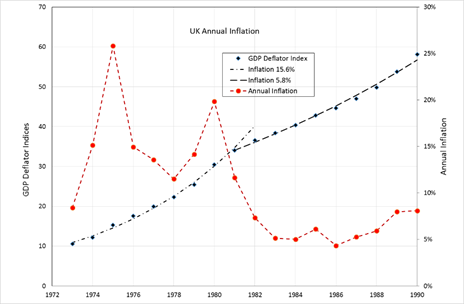Thanks to Brian Tanner for this guest blog
Independent Cost Analyst Brian Tanner discusses how to interpret the Type 22 and Type 23 costs dicsussed in Hansard...
Hansard 13 Mar 2008: Column 666W ‘Type 23 Frigate’ contains a table reportedly showing the Original Hull Costs (OHCs) of each Type 23 frigate and those same values estimated at 2007 prices. A later answer giving the same costs describes them as “actual costs at the time they were incurred”.
After a few false starts I began examining the ratios between OHC and ‘Costs at 2007 prices’. There was a striking similarity between the ratios and cost indices – GDP Deflator and Other Transport Equipment – ratios for the periods of Acceptance Date to 2007, leading to the inference that ‘Original Hull Cost’ was at Acceptance Date price levels. But that raises the question of – What is the ‘Original Hull Cost’?
There was some inconsistencies for the last four ships, but when adjustments were made to included later information the results were coherent with the other ships data.
From insider information I was able to compare the ship construction cost (shipbuilder’s contract plus Long Lead Items) with the ‘Original Hull Cost’. The ratios for the class suggest that the OHC is the Unit Production Cost at Contract Basis price level. And that meant that the escalation between Contract Basis price level and Acceptance Date is missing. Corrected table of Unit Production Cost at @ 2007 prices is opposite:
Figure 1: Type 23 Building Costs at 2007 ECs
| Ship | Name | Cost |
| T23-01 | HMS Norfolk | £266m |
| T23-02 | HMS Marlborough | £259m |
| T23-03 | N/A | N/A |
| T23-04 | HMS Argyll | £244m |
| T23-05 | HMS Lancaster | £237m |
| T23-06 | HMS Iron Duke | £219m |
| T23-07 | HMS Monmouth | £215m |
| T23-08 | HMS Montrose | £215m |
| T23-09 | HMS Westminster | £211m |
| T23-10 | HMS Northumberland | £208m |
| T23-11 | HMS Richmond | £213m |
| T23-12 | HMS Somerset | £177m |
| T23-13 | HMS Grafton | £176m |
| T23-14 | HMS Sutherland | £178m |
| T23-15 | HMS Kent | £203m |
| T23-16 | HMS Portland | £200m |
| T23-17 | HMS St Albans | £199m |
The conclusion is that the costs in Hansard are the total ship costs at Contract Basis Price level.
Turning to Type 22 frigates, the ships were built in the latter half of the 1970s and the 1980s, a period characterised by high inflation:
Figure 2: UK Annual Inflation 1972 - 1990

Any outturn costs will obviously be influenced by the spend profile, and with such erratic inflation rates normalisation will be less accurate than usual.
Also, the insider information is much less detailed requiring more assumptions to be made. On the positive side, the Type 23 analysis gives indication of the best approach to be adopted.
Starting from the inference that costs are purely for ship construction, the Hansard costs were aligned to contract price level by use of the average GDP deflator over the construction period. The ratio between Hansard and contract costs, when the omission of Long Lead Items is taken into account, is typical of the ratios existing at the time for ship construction to total cost. Any other assumption leads to incomprehensible results.
The conclusion is that the costs in Hansard are the total ship costs at Outturn (Then Years) level.
Costs have been brought to 2007 Price Levels to align with the Type 23 analysis and are shown here.
Figure 3: Type 22 Building Costs at 2007 ECs
| Ship | Name | Cost |
| T22-01 | HMS Broadsword | |
| T22-02 | HMS Battleaxe | |
| T22-03 | HMS Brilliant | £399m |
| T22-04 | HMS Brazen | £383m |
| T22-05 | HMS Boxer | £425m |
| T22-06 | HMS Beaver | £411m |
| T22-07 | HMS Brave | £391m |
| T22-08 | HMS London | £364m |
| T22-09 | HMS Sheffield | £328m |
| T22-10 | HMS Coventry | £319m |
| T22-11 | HMS Cornwall | £285m |
| T22-12 | HMS Cumberland | £299m |
| T22-13 | HMS Campbeltown | £334m |
| T22-14 | HMS Chatham | £350m |
And in conclusion:
First, a qualifying statement. This is my interpretation of the public domain data and appears to be reasonable and coherent. That the data for Type 22s and Type 23s was presented to Parliament in correct but different formats is consistent with my knowledge of how questions were answered by MoD.
